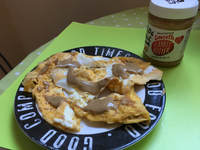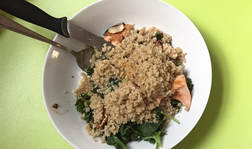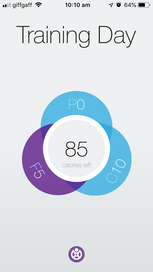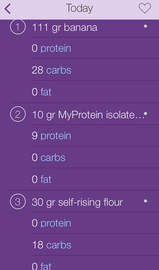Food is not just calories, it is information. It talks to your DNA and tells it what to do. The most powerful tool to change your health, environment and entire world is your fork. Welcome to Part 2 of this three-part account of my experience eating and working out to lose fat and preserve muscle mass. In Part 1, I covered my mental and physical conditions prior to this cutting phase. Today, I’m going to talk about the changes I made to my nutrition to keep it goal-oriented yet sustainable, what worked, and what didn’t. Hopefully, from the pictures above you can tell that dieting doesn’t have to be a tasteless endeavour. Let’s dive into it! ✔️What Worked I’m passionate about personality psychology, especially the MBTI model, according to which I’m an ENTJ. The J stands for “judger”, which means I feel comfortable with structures such as schedules and rules. On the other hand, spontaneity and freedom give me anxiety. That’s why, as I mentioned in Part 1, intuitive eating wouldn’t work for me as a long-term solution, though I’m sure it can benefit many others with different personality traits. ✔️The eating approach I chose for the cut is macro counting, also known as “If It Fits Your Macros” (IIFYM) or “flexible dieting”. IIFYM is how I went from a body fat percentage of 23% to 17%, but also how I took back control over my life for good. Moreover, this style of eating complements my personality as I can follow a customised set of science-based guidelines that don’t take over my existence like my disordered eating rules did. For example, I used to never have anything containing what I deemed a “high” sugar content after breakfast, with fruit being the exception. According to this dubious logic, I would have a bagel for breakfast, but never for lunch or dinner. Now I have bagels whenever I please, feel good about what I eat, and still get the physical results I want. ✔️IIFYM is still the approach that works best for me because I adapted it to my lifestyle. For years I believed there was the best way to track, and straying from it would be The End. Well, I was wrong. Ultimately, studies have concluded that adherence to your tracking method is more important than the method itself (click) because burning more energy than you consume is the primary factor underpinning fat loss (click). These two are only a few contributions to the vast body of research I discovered on the topic. For this reason, I decided to strive for 100% consistency following my own personalised guidelines, which are still the same today:
✔️I found carb cycling to be an effective tool to manage hunger (read: a sneaky way to have more carbs on training days) and still use it to this day. I was strength training three times a week, so on those three days I would eat more carbs and reduce them on the other four days. This way, the weekly total would still put me in a caloric deficit, even if it looked like I was eating “more” on certain days. ✔️Using a highly customisable tracking app helped me apply my individualised tracking rules. After playing around with MyFitnessPal and other popular trackers, I chose the Macros app by Fitocracy because you can set your own macro targets for “rest days” and “training days”, type in the macros for each individual entry yourself, and save an entry on a list of favourites to have easy access to it in the future. The user-friendly design also appealed to me for its basic simplicity. One drawback is that it only uses natural numbers, so I have to work around it, rounding up fats and carbs and rounding down protein. For example, if I’m eating something with 51.3 gr of carbs or fat, I count that as 52 gr. If it has 22.7 gr of protein, I count that as 22 gr. It’s still the app I’m using today. Here is what it looks like: To minimise the risk of unreliable results, I’ve stuck to the same apps and measuring devices for food, body fat, and body weight throughout the entire cutting phase. ✔️Eating three meals also kept my hunger at bay. One of my (many) obsessions was to have three meals and two snacks, usually fruit and nuts. I followed the same meal frequency in my intuitive eating phase, too. Fed up with this fixation, for the cut I challenged myself to only eat three times a day. These bigger meals were more satiating and less of a hassle to prepare and store in the fridge, considering I still had to go to work during the week. I also didn’t think of food nearly as much as I did when I was eating five or six times every day. Win! ✖️What Didn’t Work ✖️Not calculating my basal metabolic rate (BMR, the calories you burn at rest) and total daily energy expenditure (TDEE, your BMR plus the calories you burn from all daily activities) was my biggest mistake. Every website and calculator proposed slightly different results, so I didn’t trust them and didn’t understand the value of an estimation over no estimation at all. I preferred to adopt one of many generic templates for food intake, recommended by a female bodybuilder. According to this, you multiply your bodyweight by 1.5 to work out your protein and carbs (in grams) and by 0.5 for your fats. These templates can be useful starting points, but it’s difficult to nail the best one for your body type and activity level on your first attempt. Having calculated my alleged macro targets with several of them out of curiosity, I’ve always found that they vastly underestimate how much I should eat. In this particular case, I ended up eating around the caloric equivalent of my BMR while exercising five times a week! Yikes. It didn’t last long, though. I felt weak and stressed out, hit a weight loss plateau (my body is smarter than I am, clearly), and decided to change tactic. I then reverse dieted my way to the right macro targets for my goals, so you could say I did use the template as a starting point… but I wouldn’t recommend such a drastic beginning! Fun fact: in two weeks of reverse dieting, I lost about twice the amount of body fat shed in the two weeks I was relying on that template. With my background, eating more and more every week feels a lot scarier than dieting, so reverse dieting helped me develop more mental strength in preparation for my future bulking phase. ✖️Supplementation isn’t something that didn’t work, but rather an aspect of the process I can’t comment on. I chose to go about the cut the most natural way possible, so I didn’t try any protein powder or other supplement during the cut. I don’t feel like this has set me back in any way, but I don’t know what gains I might have made (or not) if I had been supplementing. It’s also worth noting that, due to my small frame, I don’t need as many calories or as much protein as taller and bigger individuals, so it might be easier for me to get all my needed nutrients from food alone. In Future Episodes:
To learn all about my workout regimen and see one of my workout routines, check out Part 3, coming up next! Soon I’ll also share my personal tips to maintain a cheap, healthy, and enjoyable eating lifestyle, so keep checking this space. Your Turn: What does your cutting diet usually look like? Do you use any hacks to make it more sustainable?
0 Comments
Your comment will be posted after it is approved.
Leave a Reply. |
Nikias TomasielloWelcome to my blog. I’m an online fitness coach with a passion for bodybuilding, fantasy, and bread. Want to work with me? Check out my services!Archives
May 2024
Tags
All
|
Follow me on social media |
Get in touch |
© 2018-2023 Veronica Tomasiello, known as Nikias Tomasiello – All rights reserved






 RSS Feed
RSS Feed